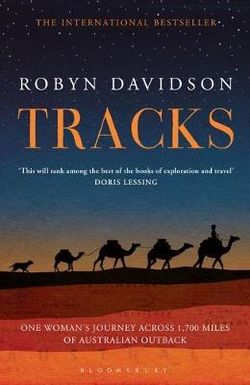This Resource is for students studying Comparative Texts AOS1 Unit 2 Year 11 in the Victorian Mainstream English Curriculum
Introduction
At first, the protagonists of Into the Wild and Tracks appear to have a certain amount in common. Both Chris McCandless and Robyn Davidson are young, idealistic, well-educated products of white, middle-class backgrounds. Their journeys are, in part, the result of belonging to an affluent generation that knows little of fear or deprivation. Both undertake significant journeys that involve challenge and hardship in their yearning for freedom. They each define this as escaping the expectations and limitations imposed on them by a materialistic society and they aim for an existence that is pared down to its essence, unencumbered by possessions or people. Hence Chris is drawn to the remote wilderness of Alaska and Robyn to the isolation of the Australian outback.
Robyn and Chris have Different Perspectives
There are other factors that influence an individual’s thinking that shape their attitudes, perspectives and values. While Chris and Robyn have family trauma in common, the McCandless family is scarred by domestic violence and the Davidson family by suicide of Robyn’s mother. However, both Chris and Robyn respond to these traumas in different ways and their responses shape their perspectives on family and feed into their motivation to travel. Chris’s journey is essentially reactive, his primary agenda seems to be to escape from his parents and the lifestyle they represent. He refuses to contact them, leaving them to despair and finally to grieve not knowing his whereabouts. In contrast, the tragedy in the Davidson family draws the family closer together with Robyn valuing the bonds with her family and in her challenge of walking with camels across the Australian desert, she has the support and endorsement of her family.
Film and Memoir
Films work largely with visual language and contains common elements to all narrative texts, such as characters and a plot, however, there are also specific features to films such as cinematography, mise en scene, editing and sound that help to create meaning and present the underlying concerns of the film.
On the other hand, a written text relies on words in order to tell its story. Robyn Davidson’s memoir Tracks is written by her and tells her own story in her own words. Nevertheless, authors make choices about how they select, represent and order material and these choices position readers to respond in particular ways. Robyn uses words to paint lyrical descriptions of the Australian landscape, conveying the beauty of the desert and its extraordinary colours.
One of the biggest differences with the film Into the Wild is that the viewers are limited by the Director Sean Penn’s interpretation and decisions about voice, structure and emphasis. Penn has to rely on secondary sources, McCandless’ writings, testimonies and interviews of people who knew him, so that Chris McCandless’ story is filtered through Penn’s own artistic perspective. The natural world is depicted in the landscapes that is predominated by the camera which shows us the beauty that attracted Chris to his life of solitude in Alaska. We see Alaska when Chris first arrives in all its wild majesty that is illustrated by sweeping wide-angle shots of the mountains.
What is Tracks About?

Tracks is Robyn Davidson’s 1980 personal account in a memoir, detailing her perilous journey through 1700 miles of Australian outback and the remarkable character transformations that take place throughout. The events of the story begin in 1973, when a young Robyn Davidson arrives in Alice Springs with an outlandish plan to train wild camels to accompany her through the Australian desert. When, after two years of gruelling training, she receives a sponsorship from National Geographic, her journey can finally go ahead on the condition that a photographer Rick Smolan accompany her (for some parts of the trip) and document the journey in photos. As Robyn delves deeper into the journey, each day brings new discoveries about the camels, the landscape, the people of Australia, and ultimately, herself.
What is Into the Wild About?

Into the Wild (2007) is a non-linear survival film directed by Sean Penn, which is based on Jon Krauker’s 1996 novel of the same name. It recollects the final few months of the life of Christopher McCandless as he departs from society in both an act of resistance as well as a means of self-discovery. A bright young college student in the 1990s, McCandless abandons his family and affluent lifestyle to embark on a frontier-style journey into the Alaskan wilderness. Troubled by a dysfunctional family and disenchanted with the materialistic excesses of 1980s America, McCandless seeks a radical engagement with nature, in the style of his literary heroes Henry David Thoreau and Jack London. After 113 days in the wilderness, he suffers from starvation and dies. The true story of McCandless’ journey renders the film an important depiction of self-reliance, isolation, and the unparalleled power of nature. Penn’s film offers strong commentary regarding the materialistic, consumerist nature of modern living, whilst also ultimately emphasising the more humanistic importance of family and love.
Themes in Both Tracks and Into the Wild
| Self-discovery in nature | Resistance to conformity & independence | Personal journey & quest |
| Desire for freedom & cost of true freedom | Identity, belonging & home | Rejection of materialism & class |
| Conflict with family & traumatic childhood | Survival | Gender issues & misogyny |
| Relationships with animals | Relationships with humans & need to love | Perception and illusion |
| Itinerant lifestyles | Loss and grief | Reconciliation & forgiveness |
| Loneliness | Planning & preparation | Isolation |
| Nature is unpredictable | Courage, resilience & risk taking | Entrapment |
| Seeking happiness | Seeking truth | Transcendence & spiritual awakening |
| Dispossession of Indigenous Australians in ‘Tracks’ & racism | Mastering fears | Starvation & death |
